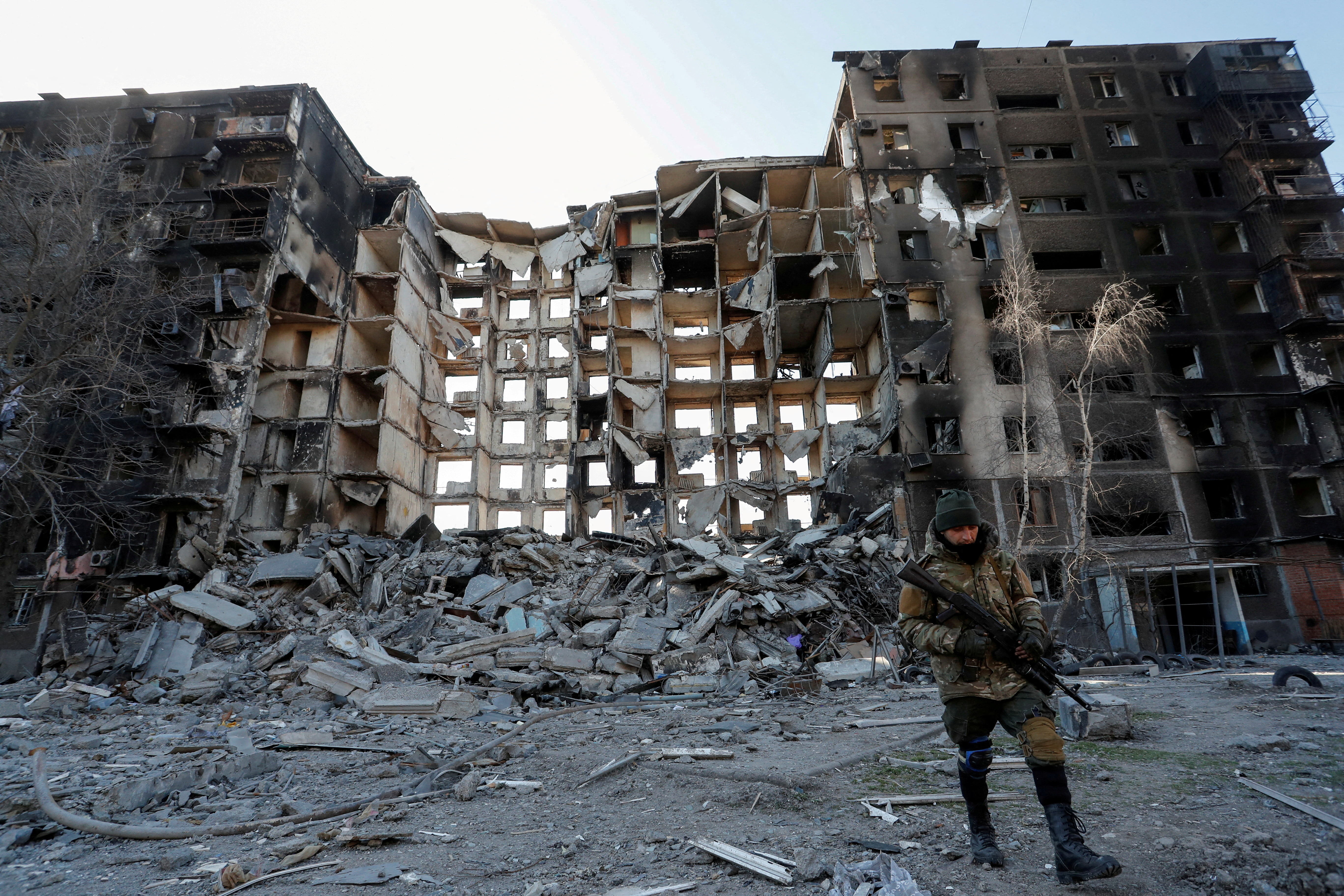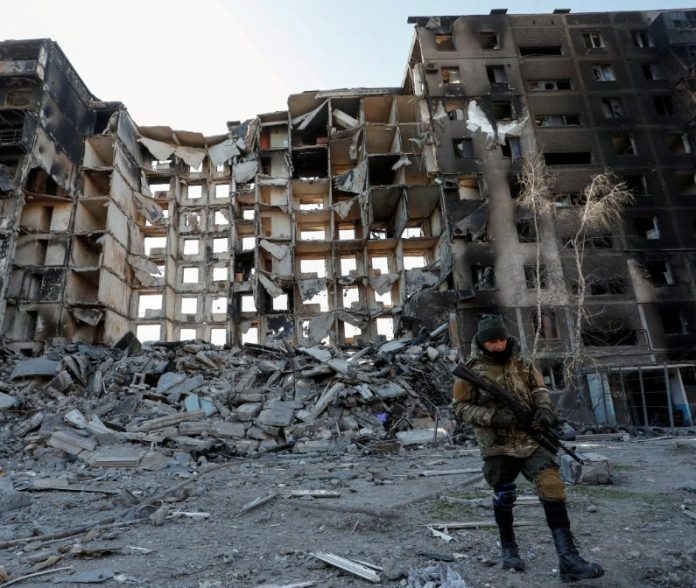Soon after Russia’s invasion of Ukraine on February 24th of this year, the Ukrainian port city of Mariupol has been surrounded and besieged by Russian forces for nearly 70 days. The city, once home to nearly 400,000 people, has been virtually destroyed in months of heavy street combat, as Russian and Ukrainian troops desperately fought, block by block, for the strategical key port city. By May 6th, the Ukrainian military presence in the city had been reduced to a small steel production complex, the Azovstal steel plant. The dogged defense of Mariupol against the odds of the better-armed Russian military, and the war crimes committed by the invading Russians on the civilian populace, exemplify the unsuccessful strategies Russia has utilized in the invasion of Ukraine. Also, the fierceness of Mariupol’s defense offers a glimpse into the future of this destructive conflict.
Background
The city of Mariupol has a long history related to Russia and wars. Once a Cossack encampment, the Russian Empire established Mariupol in 1778. As the Russian Empire transitioned into the USSR, Mariupol became heavily industrialized and saw massive steel mills constructed for the processing of heavy metals. During WW2, the city was occupied by German forces but was retaken after heavy fighting. Throughout the Cold War, the Soviets underground bunkers underneath the Azovstal Factory, an iron and steelworks, to protect against possible American nuclear strikes. Then in 1991, the newly independent Ukrainian government took control of the steel plant and the city of Mariupol.
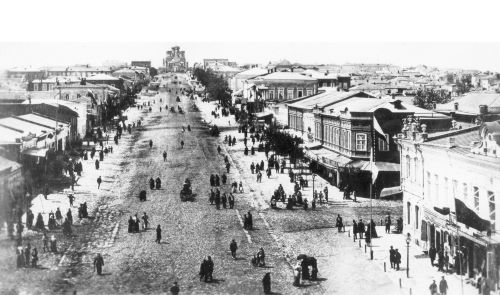
But in 2014, Ukraine suffered jolts of civil war, corruption, and anti-government protests. After the pro-Russian president rejected calls from the Ukrainian public to form closer ties to the EU, massive protests broke out in Ukraine against the government. Whilst this was occurring, ethnic Russian separatists in eastern Ukraine declared independence and broke away. Eventually, the Ukrainian government reorganized itself and declared the new separatists in the east illegitimate. Violence erupted across eastern Ukraine as pro-Russian separatists fought Ukrainian forces for control of several oblasts, or provinces. Mariupol was taken over by pro-Russian separatists of the Donestk People’s Republic (DPR). The DPR’s hold on Mariupol was untenable as the Ukrainians retook the city, but the DPR attempted to retake the port town. The Ukrainian military heavily fortified the city, permanently stationing thousands of troops and building elaborate fortifications systems.

Mariupol’s status as a large, industrialized, and strategically positioned town are the reasons it has so often been bitterly fought over. It is a regional capital with factories, railroads, and a developed port. It also is located on the Sea of Azov, where naval ships could be stationed. And it is located near the DPR, so both sides seek to control the city. Between 2014 and 2022, the Ukrainian military stationed over 3,500 troops in the city as fears of a Russian invasion were rampant. The Azov battalion, a former paramilitary organization that we will discuss in-depth later, has the bulk of its forces stationed in Mariupol. Months’ worth of supplies in the form of food, ammo, and equipment were stationed beneath the Azovstal Factory in case of a prolonged siege. Mariupol, by 2022, was a fortress city and well prepared for a possible enemy attack.
The Russian invasion and initial engagements
On February 24th, 2022, Russian forces attacked through Belarus in the north to Kyiv, the capital of Ukraine, and attacked from the east into the Donbas region, the invading armies also attacked southern Ukraine. Russian troops fighting in southern Ukraine came from Crimea, a peninsula that Russia annexed from Ukraine in 2014. Some Russian forces turned west towards Kherson, and some turned east towards Mariupol.

Mariupol is east of Crimea and west of the DPR, so it is strategically disadvantaged and between two possible invasion routes. Thus, a siege was always on the mind of the Ukrainian military leadership. The defenses of Mariupol consisted of the 800-strong Azov Battalion, a former paramilitary organization that was created in 2014 to help the Ukrainian government resist the pro-Russian separatists in the Donbas, and about 3,000 other Ukrainian military personnel including the elite Ukrainian marines.
The Azov Battalion’s controversial history
The Azov Regiment, one of the Ukrainian army units defending Mariupol, was founded by staunch anti-Russian resistance fighters from across Eurasia and former Soviet territories. The battalion has its roots in Ukrainian nationalism and far-right politics, and western media began to circulate reports that many members of the Ukrainian unit were Neo-Nazis. The unit’s insignia is the Wolfsangel, an ancient Germanic symbol appropriated by the Nazi SS, or the military arm of the Nazi Party before and during WW2. Footage from a German television network showed Azov Battalion members wearing the Swastika or SS lightning bolt symbols on their helmets. The Telegraph, a British newspaper, interviewed an Azov member who said: “Personally, I’m a Nazi, I don’t hate any other nationalities but I believe each nation should have its own country.”
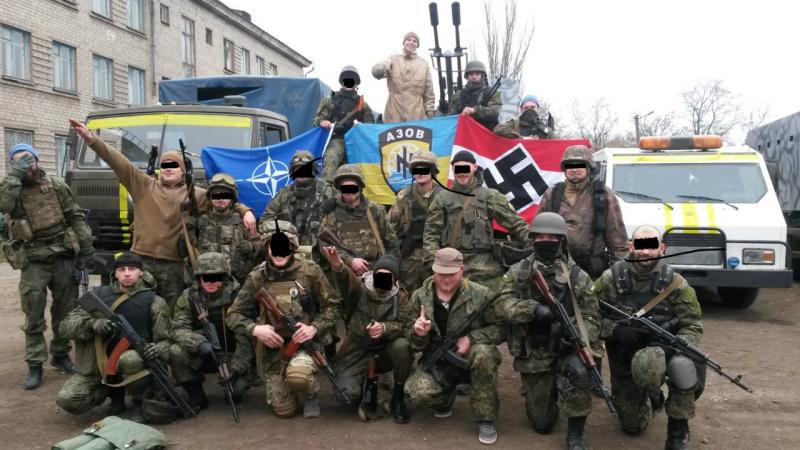
As the years went on, the Azov Battalion gained respect from the Ukrainian Army for its ferocious combat abilities. The unit retook Mariupol from separatist forces in 2014 and has repeatedly launched attacks against the DPR’s attempts to retake ground for their country. By 2022, the battalion had undergone a significant reorganization and shed most of its Neo-Nazi rhetoric and members. As the Washington Post states: “Under pressure from U.S. and Ukrainian authorities, the Azov battalion has toned down its extremist elements.” The Washington Post article quoted Colin P. Clarke, a director of research at the Soufan Group, an intelligence and security consulting firm, as saying:
“While the far-right element is still a factor, I think it’s a much smaller part of the overall whole. It’s been diluted, in some respects.”
“We don’t identify ourselves with the Nazi ideology,” said Azov Battalion founder Colonel Andriy Biletskiy, aged 41. “We have people of conservative political views, and I see myself as such. But, as any person, I don’t want my views to be defined by others. I’m not a Nazi. We completely reject it.”
As of 2022, the Azov Battalion remains a controversial fighting force. On one hand, they have been lauded by Ukraine as an elite cadre of fighters, willing to do all they can to resist Russian aggression. “These are our best warriors,” Ukraine’s former president, Petro Poroshenko, stated. And they have seemingly removed most of their Nazi rhetoric and mostly remain a nationalist, right-wing element in Ukraine’s army. For Ukraine, they represent a crack unit of hardline nationalists determined to resist Russia, and for that, they are considered heroes.

Russia’s troops in the siege
Russian forces in the siege of Mariupol reflect the diversity of units they have deployed all across Ukraine. Included in the besieging army were regular Russian army units, Donestk Russian separatists, and allied Chechen troops which represent a diverse array of troops fighting for the Russian army. First, regular Russian infantry makes up the bulk of the Russian force and is considered decently trained and equipped. According to the Warsaw Institute, a Polish foreign policy think tank, included in the Russian army is a battalion of Spetznaz. This elite group operates in special operations such as infiltration, counterintelligence, and reconnaissance.
The Donetsk People’s Republic has several military units that took part in the battle for Mariupol. These units included the Sparta and Somalia battalions, which were created in 2014 by pro-Russian separatists to secure the region’s independence from Ukraine. The quality of the DPR forces in Ukraine varies widely. However, they have been trained and equipped by Russian military advisors for years.
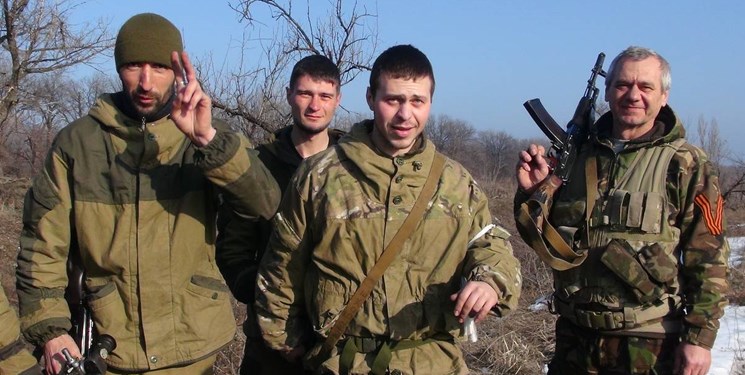
Finally, there are the Chechen troops fighting alongside the Russians. In the 1990s, Russia invaded Chechyna, a region to the south of Russia in the Caucasus Mountain Range. The Russian government wished to subjugate the former Soviet state to deter future terror attacks through a full-scale invasion. Consequently, brutal guerrilla warfare emerged in the region between Chechen Islamic rebels and Russian troops. The Chechen capital of Grozny was utterly annihilated by Russian airstrikes and a direct ground assault, and war crimes were committed by both sides.

But in 2009, the insurgency died down to the point where the Russians declared that the invasion was over. A pro-Russian government was installed, now led by Ramzan Kadyrov who formed the 141st Special Motorized Regiment to fight in Ukraine. Specifically, Russia deployed the regiment to Mariupol, where they hoped that their experience in fighting in destroyed cities like Grozny would come in handy.
Kadyrov also appears to take a personal interest in sending his Chechens into Ukraine. “He appears to see the invasion of Ukraine as an opportunity to boost both his power and his profile. Sending his men is a way for Kadyrov to prove his loyalty to [Putin] whose patronage is the basis of his authority,” the Guardian’s Emma Graham-Harrison reports.
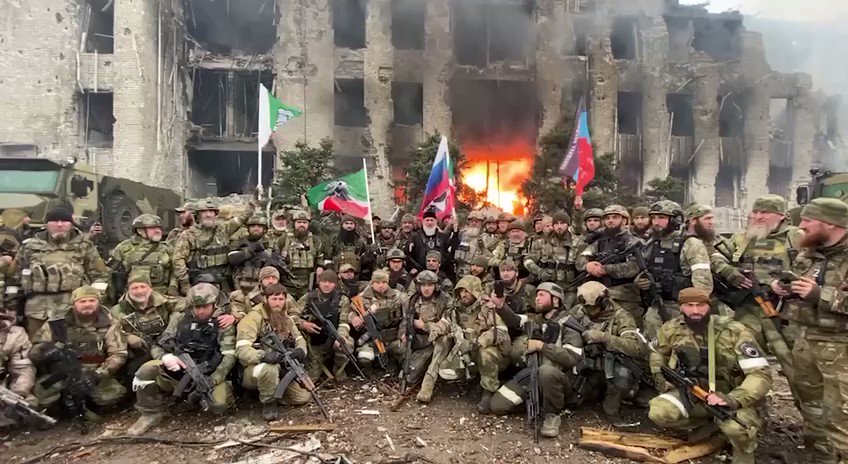
Like in other parts of Ukraine, Russia utilized a wide variety of troops for the campaign. Regular Russian army units, Pro-Russian separatists, and Chechen mercenaries are some of the most common Russian ground units seen in the war so far.
Siege of Mariupol
From February 24th to March 2nd, Russian troops from the west and Donetsk troops from the east raced to Mariupol, brushing aside light Ukrainian defenses. By March 2nd, DPR artillery was bombarding Mariupol’s outer suburbs. For hours Russian artillery pounded the port city. Deputy Mayor Sergei Orlov commented that “We do not have electricity in the whole city, we do not have water supplies, we do not have sanitary systems, we do not have heating.”
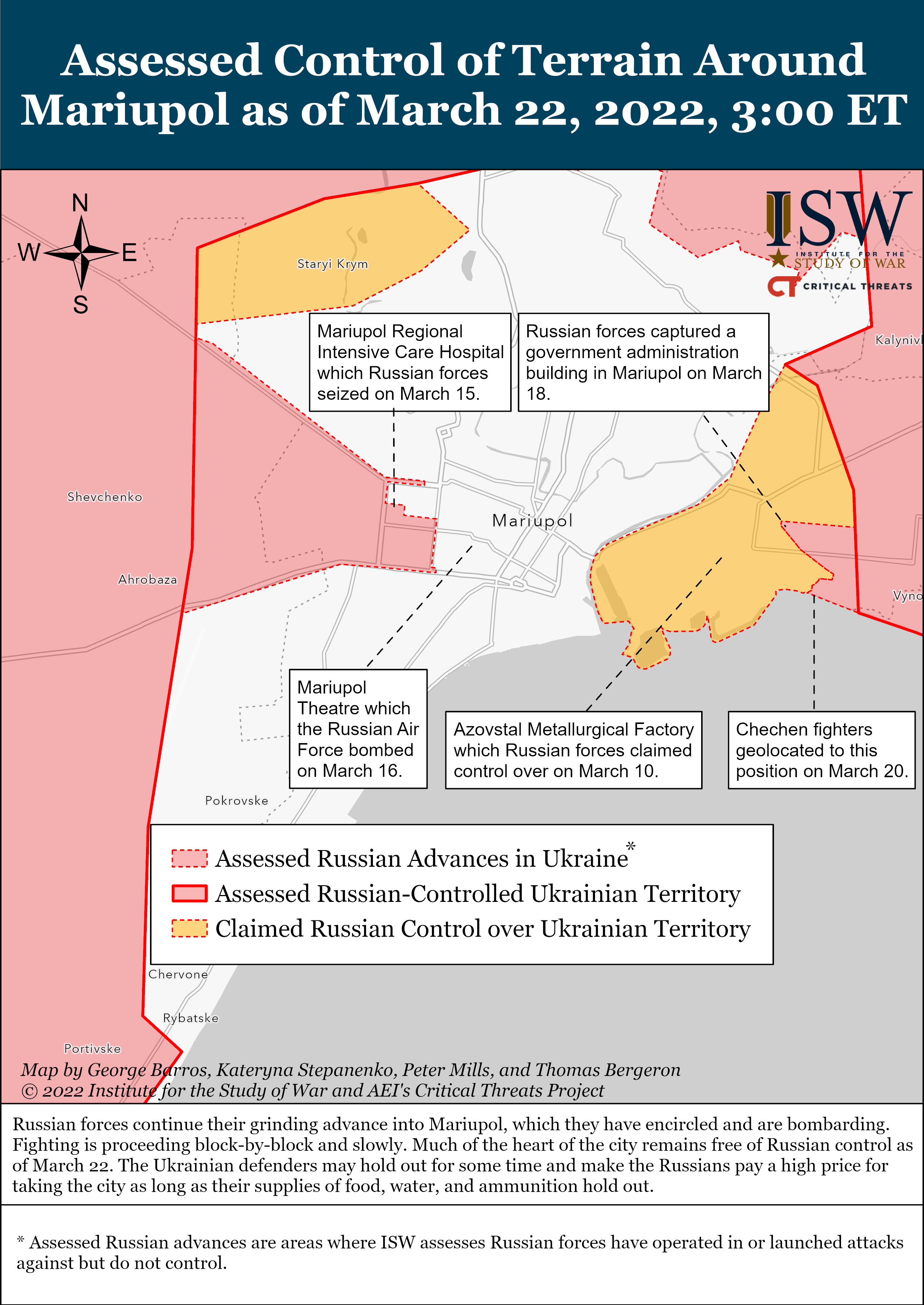
By March 5th, the city was firmly surrounded by Russian troops to the west and north, DPR forces to the east, and the Sea of Azov to the south. The Red Cross, realizing that the city still had hundreds of thousands of residents and that supplies were quickly running out, quickly announced plans to organize a humanitarian corridor to allow the civilians to escape. The need to evacuate the civilian population was urgent, one resident told the BBC that “I can hear shelling every three to five minutes.” But according to the Ukrainian military and the Red Cross, Russian forces began to shell the evacuation corridors with artillery, causing the civilians to retreat back. As the Red Cross stated: “Amid devastating scenes of human suffering in Mariupol, a second attempt to start evacuating an estimated 200,000 people out of the city came to a halt.”
The Russian military appeared to deploy significant amounts of forces to surround Mariupol. Initially, Russian forces appeared content to probe Ukrainian defenses and hit them from afar with airstrikes, multiple launch rocket systems, and artillery. Satellite imagery from Maxar Technologies showed the damage done to apartment buildings, shopping centers, and parks. It became painfully clear that the Russian attack on Mariupol was focused on inflicting as much damage to the city – and its population – as possible.
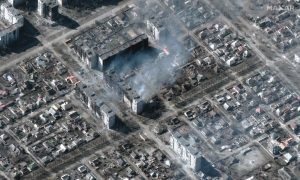
As hundreds of Ukrainian civilians and soldiers were killed by incessant shelling, Mariupol residents were buried in a mass grave near a city cemetery. This practice, which became more common as the days went on, highlighted the brutal effects of Russian shelling on the noncombatant population – and the rapidly deteriorating position of the Ukrainian defenders in the city. On March 9th, a Russian airstrike hit a maternity hospital. Initially, the Associated Press reported that 17 people were injured, and a reporter managed to arrive at the bombed-out hospital to a horrifying sight. The reporter commented that “a children’s hospital and the central fire department among those hit [by airstrikes].” Three pregnant women who were inhabiting the hospital were injured, with one being carried away on a stretcher. Both she and her unborn baby died due to wounds from the bombing. The other two women were evacuated safely with minor wounds and safely gave birth.
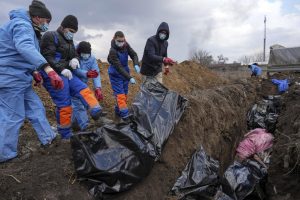
Russian advance into the city
By May 11th, Russian troops were attacking the outlying neighborhoods of Mariupol. Russian armored columns attacked for days on end, being repeatedly forced back by determined Ukrainian defenders and artillery strikes. Ukrainian defenders were well equipped and fought savagely to defend the city, as additional Russian troops continued to pour into the siege. On March 15th, Russian Major General Oleg Mityaev was killed in action whilst attempting to spur on his troops, a major blow to the Russian offensive.
The Russians continued to make steady advances from March 11th to March 22nd, as they slowly tightened their grip on the city. The city council of Mariupol alleged that in occupied parts of the city, Russian forces were forcefully deporting Ukrainian citizens to Russia. This could possibly be motivated by a desire to alleviate the logistical burden that taking care of so many civilians would entail, or a fear that the Mariupol residents would conduct partisan warfare against the occupiers. Thus, the outlying regions of the city were virtually depopulated by late March.

A written order to the Ukrainian garrison to surrender was rejected by the Ukrainian government. As the news source Firstpost writes:
“Ukrainian officials rejected the Russian proposal for safe passage out of Mariupol even before Moscow’s 5 a.m. deadline for a response came and went. ‘There can be no talk of any surrender, laying down of arms,” Ukrainian Deputy Prime Minister Irina Vereshchuk told the news outlet Ukrainian Pravda. “We have already informed the Russian side about this.'”
Effects on Civilians
Throughout the siege, the civilian population of Mariupol suffered horrifically. Targeted by Russian artillery and aircraft, many of their homes and apartments were leveled during the fighting. And with supplies like food, water, and medicine running dangerously low as the Russians blocked off the city, thousands were at risk of death from illness, thirst, or starvation. Thousands more were left shivering in basements as the heating was shut off by a lack of electricity in a city where temperatures plummet to below freezing. The threat to civilians in the form of direct Russian attacks was illustrated in two tragic cases.
In another instance of Russia’s blatant disregard for the safety of civilians, a theater that was being used as a bomb shelter by unarmed women and children was struck by a bomb on March 16th. The theater, according to Associated Press correspondents, housed close to 1,000 people and was virtually destroyed. Initial reports of the death toll were 300 – but that number has risen to over 600 in the wake of witness testimony and investigation by reporters. AP news quoted one distraught survivor as saying, “This is one big mass grave.”
The worst part of the story is that the Ukrainian civilians inside had written the words “children” in Russian in the front and back parking lot of the theater. As AP News reports: “The theater’s set designer used white paint to inscribe the word ‘CHILDREN’ in Cyrillic letters on the pavement outside, in the hope of staving off an attack from above. The signs, painted in both the front and back entrances, were large enough to be read even from satellites.”
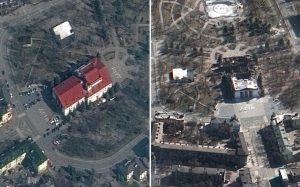
The results of these crimes against humanity were swift. Foreign states like the US, United Kingdom, and other European nations have described the Russian actions in cities like Mariupol as “war crimes.” US President Biden described Russian President Putin as a war criminal whilst he was visiting Poland. After witnessing the brutality of Russia’s assault on Mariupol, Russia has rapidly lost its standing on the world stage. And the war crimes against innocents may have hardened the Ukrainian defender’s will to fight. “Ukrainians are not going just to let this happen. “They feel very strongly about their country, and national sovereignty and they will fight,” said Eugene Bondarenko, a lecturer at the University of Michigan’s Department of Slavic Languages and Literatures.
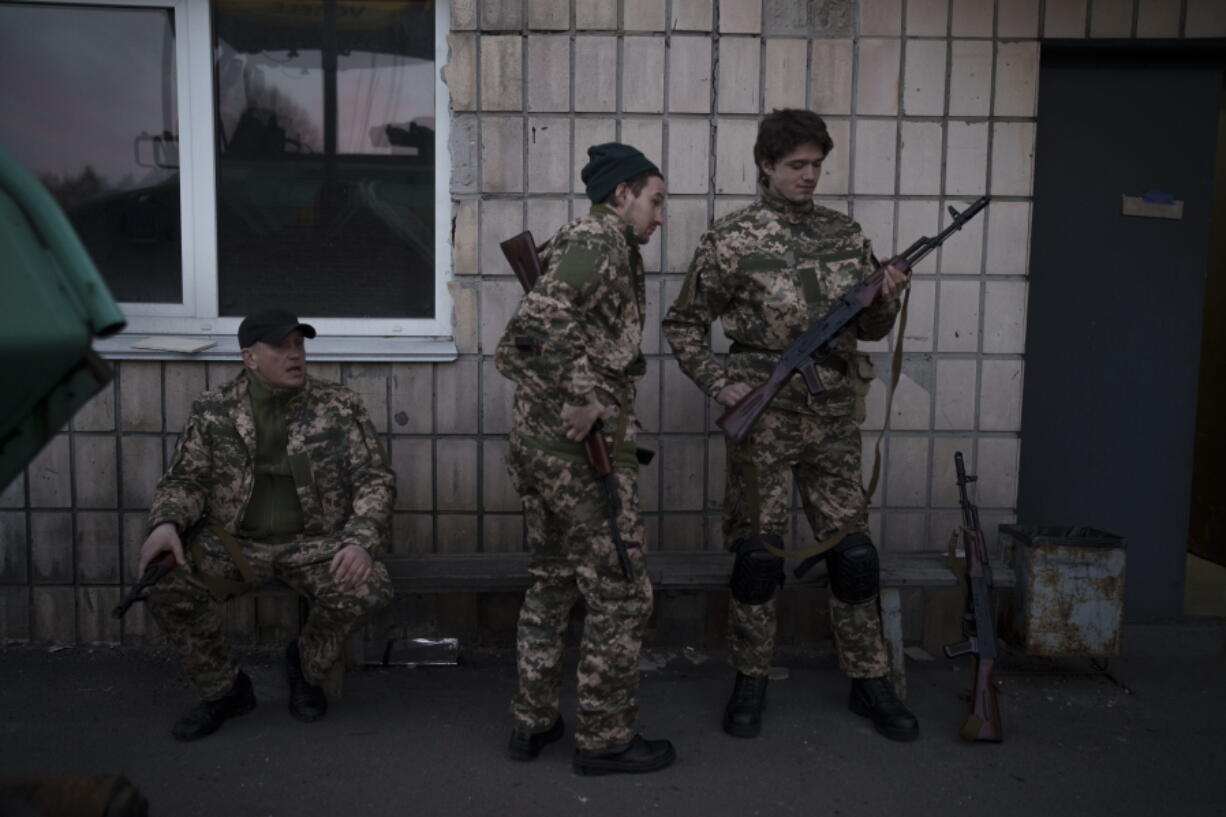
Bondarenko would go on to say that “imagine you’re Ukrainian. It is your city being bombed and your country being “demilitarized.” The leadership is being hunted down under the guise of “de-Nazification” to make space for a puppet government. Facts be damned—there are no neo-Nazis to be found and Ukraine’s immensely popular president happens to be Jewish and is extremely unlikely to be a neo-Nazi. Putin has come to destroy Ukrainian culture, language, society, and statehood. That’s why Ukraine fights.”
Russian gains and final pockets of resistance
By March 23rd, the Ukrainian defense of Mariupol has significantly deteriorated to the point where the Mayor of the city and other important government officials had fled. By that time, Russian forces from the west had taken a church in the center of the city, threatening to cut the defenders of the city in half. Radio Free Europe wrote that “Mayor Vadym Boychenko said that Russian forces controlled some neighborhoods and were entering ‘deeper into the city’ of almost half a million people before the war. But, Mariupol remains ‘under the control of Ukrainian armed forces.’
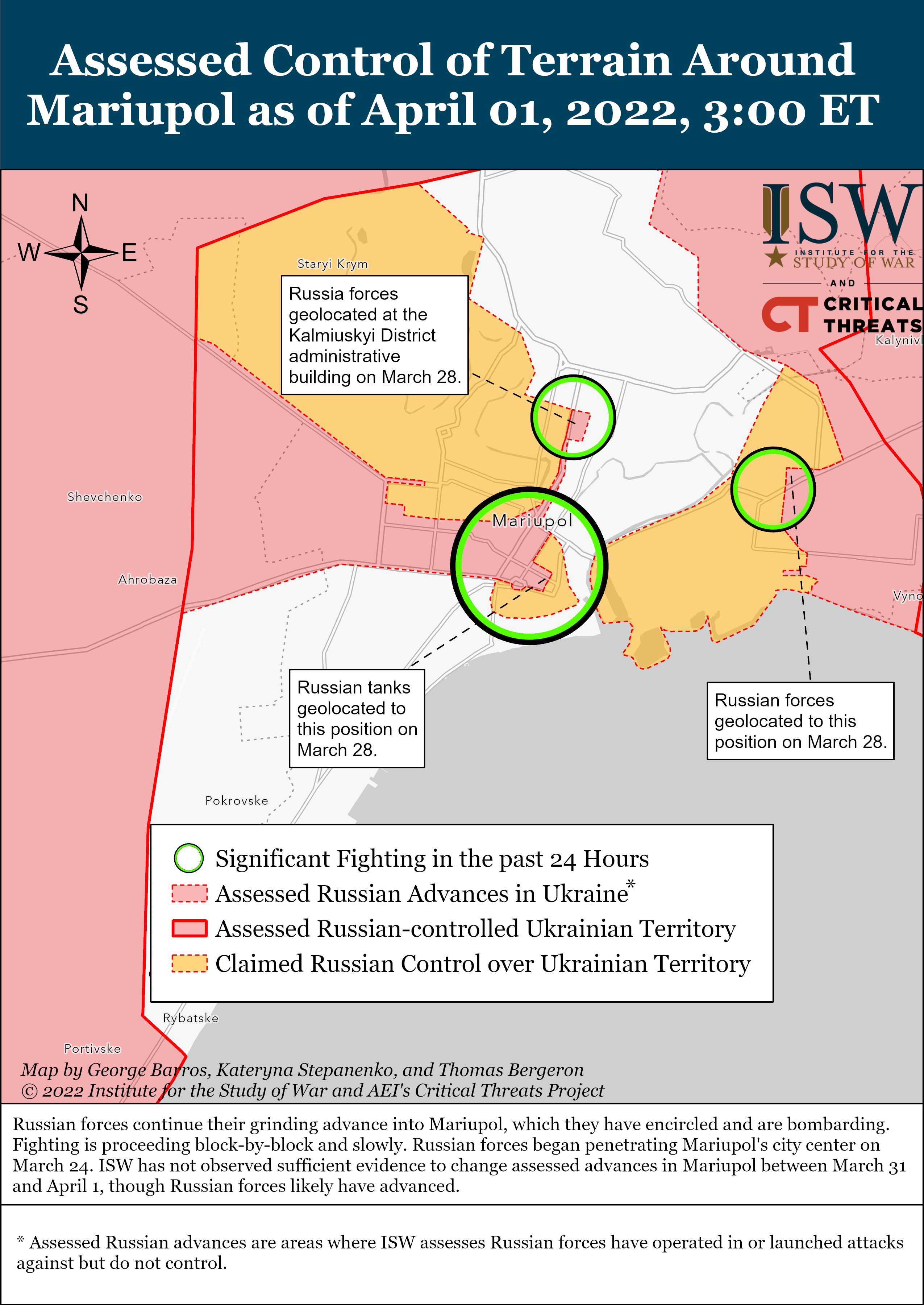
‘Mariupol needs a complete evacuation,’ Boychenko told the local UNIAN news agency in an interview published overnight. Boychenko said about, “40 percent of Mariupol’s affected residential buildings are now uninhabitable.” As supply shortages continued to worsen in Mariupol, and as the Russians began to deploy more firepower in the urban fighting, the city center of Mariupol fell by April 7th. In the following days, hundreds of Ukrainian soldiers surrendered to Russian forces.
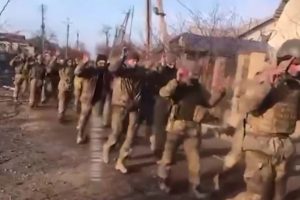
By April 13th, the remaining Ukrainian forces had been divided into 3 sectors of defense. The first was in the southwest, by the Mariupol port. It mostly was defended by a motley crew of Ukrainian Territorial Defense forces (militia called up to defend their home towns or cities), Ukrainian army members, and the Azov Batallion. Towards the northeast, the Illich metallurgical combine was manned by the Ukrainian marines, otherwise known as naval infantry. The marines in the Ilyich metallurgical combine were cut off from the port defenses but still had contact with the Azov Battalion stationed in the Azovstal ironworks, where the strongest Ukrainian defenses lay. As the military newspaper, SOFREP reports: “there are three areas not occupied by Russian forces: the Illich factory, the Azovstal iron and steelworks factory, and the port area south of the maternity area that was bombed by the Russians. All three locations are surrounded by Russian forces who have either complete control or are partially advancing. There is no clear path out of the city as all three locations have their backs against either the Sea of Azov or advancing Russian forces.”
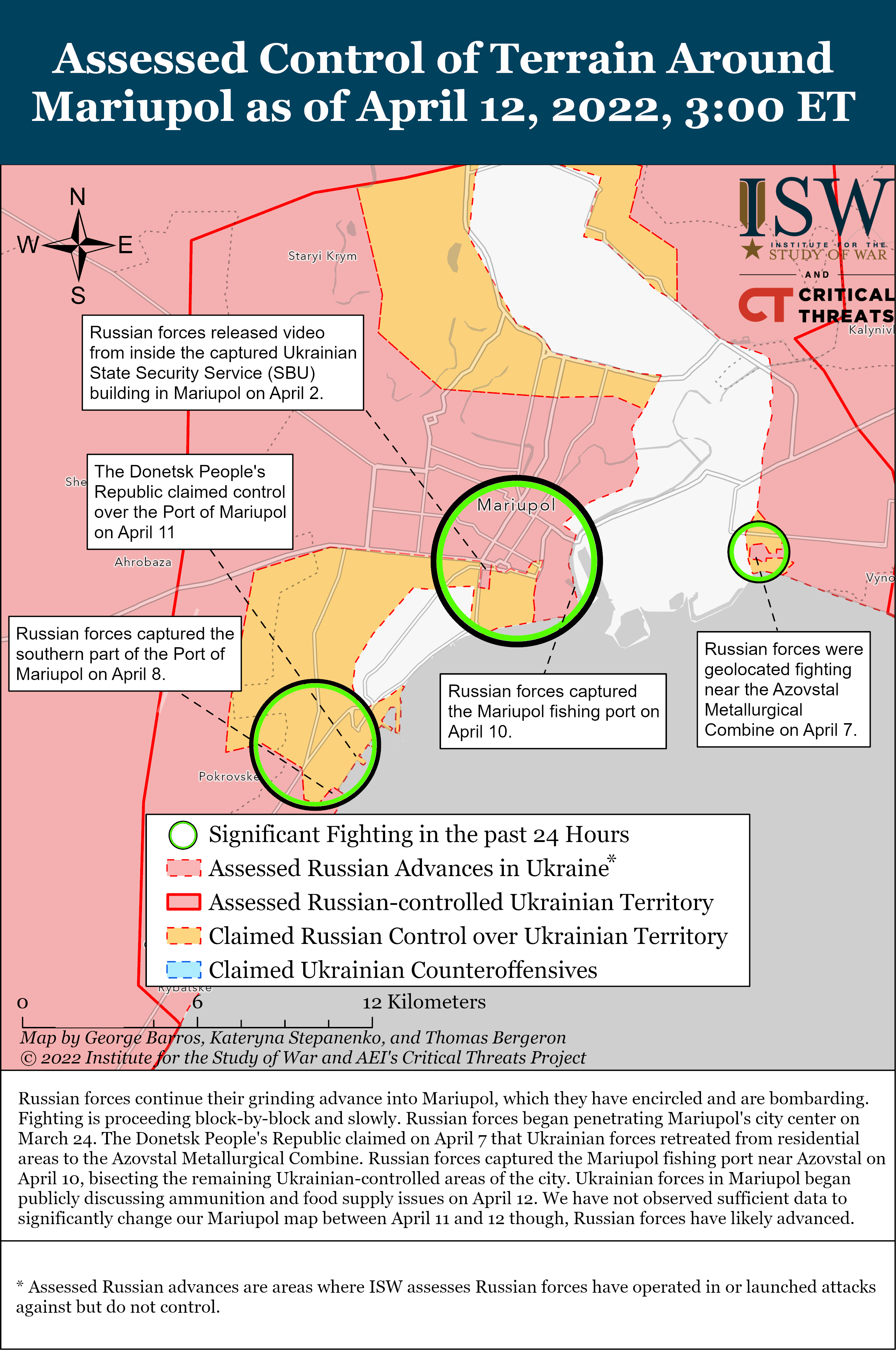
But on April 12th, the 36th Marine Brigade, which was defending the Illich plant, posted on Facebook that time was running out for the defenders. “Today will probably be the ultimate battle, as there is no ammo left,” said the post. “Beyond that: hand to hand fighting. Beyond that, for some death, for others capture. For more than a month, the Marines have fought without refills of ammunition, without food, without water,” they wrote. “The mountain of wounded makes up almost half our crew.”
After a breakout attempt, during which some of the Marines successfully linked up with the Azov Battalion in the Azovstal factory, the Russians stormed the Illich plant. The Russian government reported that 1,026 Ukrainian Marines had been captured, a heavy blow to Mariupol’s defense as now only two pockets of resistance remained.

From April 12th to April 17th, Ukrainian forces now were concentrated either in the southwest of the city near the port or in the east in the Azovstal plant. Heavy block by block fighting occurred, with the Ukrainians utilizing shoulder-launched anti-tank missiles to destroy Russian armored vehicles. Snipers on both sides set up positions in the ruined apartments and shopping centers of the city to target soldiers. Firefights erupted between Ukrainians and Russians that occupied separate houses, and hand-to-hand combat was reported in the Azovstal and Illich plants.

Even as Russia made steady progress in late March and early April, Ukraine managed to inflict heavy losses on the invaders and significantly delay their conquest of the port city. On April 4th, the newspaper Foreign Policy wrote an article titled “Russia’s Urban Warfare Predictability Struggles.” The article stated that despite Russia’s technological prowess, the struggles of urban warfare in bombed-out, destroyed cities like Mariupol allow the defenders to remain in strong, stationary defensive positions.
“Since 2008, Russia has spent billions of dollars modernizing its armed forces, updating Soviet-era systems, developing and buying sophisticated military equipment, and professionalizing its troops,” the article wrote. “Large-scale Russian military exercises showcasing integrated air defenses, heavy artillery, and sophisticated electronic warfare capabilities, as well as the intense and destructive air campaign Russia carried out in Syria and the hybrid tactics it has used in eastern Ukraine since 2014 all, display a battle-hardened, professional military that many expected would quickly overwhelm the Ukrainians.”
The rudimentary mistakes the Russians are making are therefore baffling. Media coverage of Russian movements shows failures in basic tactics, such as lack of infantry support for tanks and its inability to coordinate air support with ground movements as well as its failure to properly plan for resupplies of food, fuel, and ammunition.”

The Russians are taking a beating—but urban warfare has humbled far superior forces, including the U.S. military.
As a rule, militaries prefer to avoid fighting in cities, knowing full well that an urban fight is bound to be brutal, costly, and time-consuming. Cities favor the defender, who has the advantage of local knowledge. Dense urban terrain full of multistory buildings, narrow roads, and underground spaces also limit the use of concentrated armored vehicles, forcing militaries to disperse their soldiers and leaving them vulnerable to sniper fire and ambushes.”
Last Stand at the Azovstal
Russia managed to capture Mariupol’s port by April 17th, reducing the number of pockets in the city to one – the Azovstal metallurgical combine. With most of the city in Russian hands by the end of April, the Russian military declared a victory in the shattered ruins of a once-bustling port city, despite the fact that over 2,000 Ukrainian fighters were still resisting in the Azovstal. Hundreds of civilians fled inside the safety of the plant, which as I mentioned above possesses strong bunkers, a maze of underground tunnels, and stores of food and water stationed there by the Azov Battalion. “It’s like a big city,” too dark and tangled to navigate. “You couldn’t see what was in front of you, so you stay in places you know,” said Maiia Krylova, a 14-year-old in an interview with NPR.
On April 17th, the Russians informed the Ukrainian defenders at the Azovstal that if they did not surrender, they would face destruction. “All those who will continue resistance will be destroyed,” stated Maj. Gen. Igor Konashenkov, the Russian Defense Ministry’s spokesman. But the Ukrainian government rejected the ultimatum, stating that: “We will fight absolutely to the end, to the win, in this war.”
Realizing that a fight in the Azovstal would cost Russia dearly, Russian President Putin stated in a publicly televised meeting with his Defense Minister Sergei Shoigu that storming the plant would be too costly. “The completion of combat work to liberate Mariupol is a success,” declared Putin. “There is no need to climb into these catacombs and crawl underground through these industrial facilities, block off this industrial area so that not even a fly comes through.”
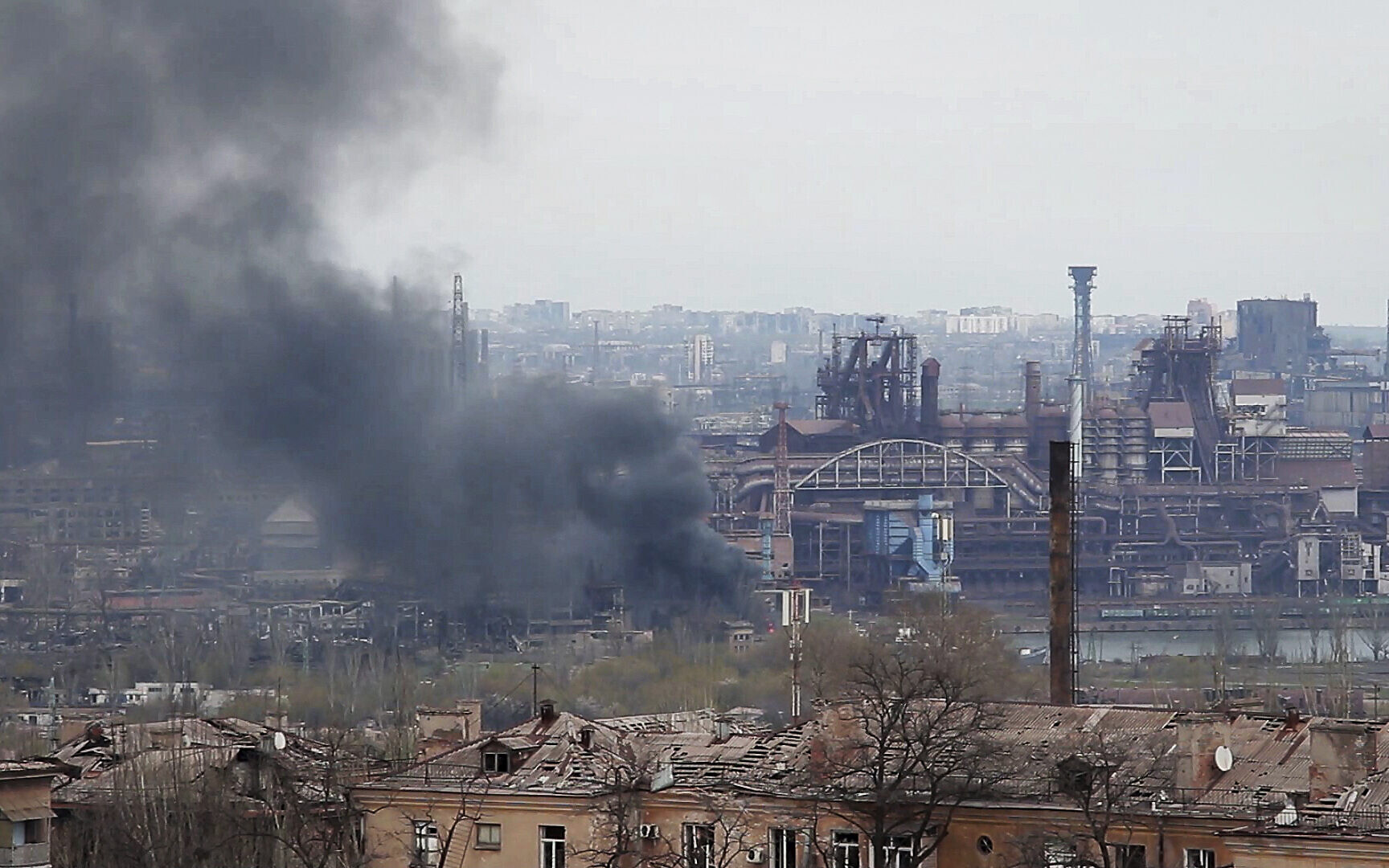
Inside the Azovstal, a Ukrainian army sergeant told the New York Times that the situation inside the steelworks was desperate.
“I’m alive and healthy for now, but the situation is very difficult,” said Kuznetsov, who is 25. “We’re at the end of our food and water. We have about 1,000 civilians at the factory. I can’t say how many soldiers we have. There are many, many wounded and not enough medicine. The smallest injury can be fatal; there are not even simple bandages.”
Russian artillery and aircraft pounded the Azovstal with over 50 long-range bombers and short attack aircraft, causing plumes of smoke to rise from the plant. Reportedly over 500 Ukrainian soldiers and civilians were killed or wounded by the airstrikes. The airstrikes may have been called to soften up Ukrainian defenses prior to a ground assault or were meant to demoralize the defenders into surrender.
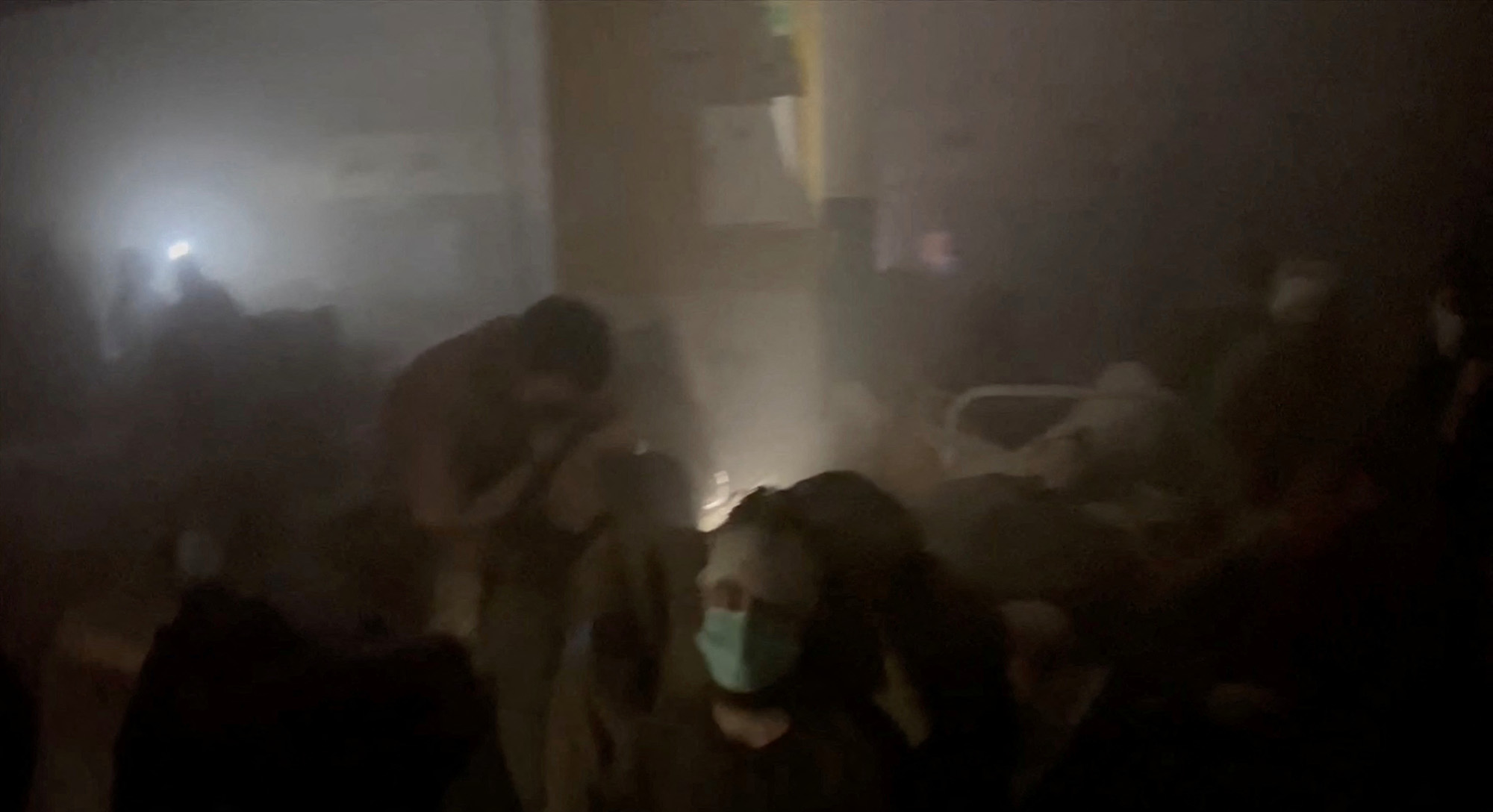
But the Ukrainian defenders at the Azovstal declared that there would be no surrender. “We will continue to fight as long as we are alive to repel the Russian occupiers,” stated Captain Sviatoslav Palamar, a deputy commander of the Azov Regiment. As of now, Russian forces have stormed the Azovstal, and fighting rages on in the last bastion of Ukrainian resistance in Mariupol. The situation of the defenders, allegedly out of food, water, and ammunition, remains bleak. Should the Russians continue their offensive, the Azov Battalion will likely go down fighting in the factory.
Just as the invasion has forced Ukraine to halt its export of wheat, causing an increase in prices, so too has the siege affected the global economy. The Azovstal and Illich metallurgical plants once produced thousands of metric kilotons of steel and helped boost Ukraine’s stance as the world’s 4th largest steel exporter. But as Russian missile attacks and artillery strikes hit Mariupol, the plants shut down. This has driven a demand for raw materials like steel in Europe and has led to a substantial increase in prices.
Conclusion
The Siege of Mariupol will go down as one of the most brutal and destructive sieges in modern history. Mariupol’s annihilation at the hands of Russia may be foreshadowing the steps Russia is willing to take to break the back of Ukrainian resistance. This determined resistance of the city mirrors how Ukraine has managed to beat back Russian attacks and avoid complete defeat despite confronting larger enemy forces. And horrific Russian assaults occur resemble the indiscriminate bombing of civilians and the deliberate massacre of civilians in towns like Bucha. As soldiers clash in the tunnels of the Azovstal, we can use this siege as a microcosm for the war in Ukraine as a whole.
